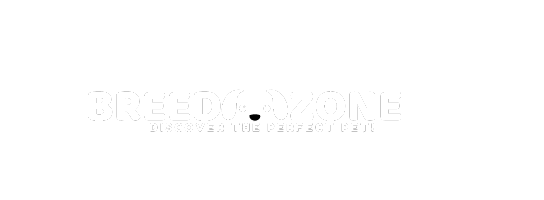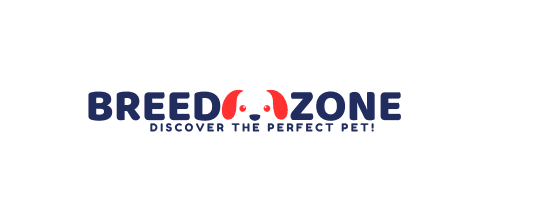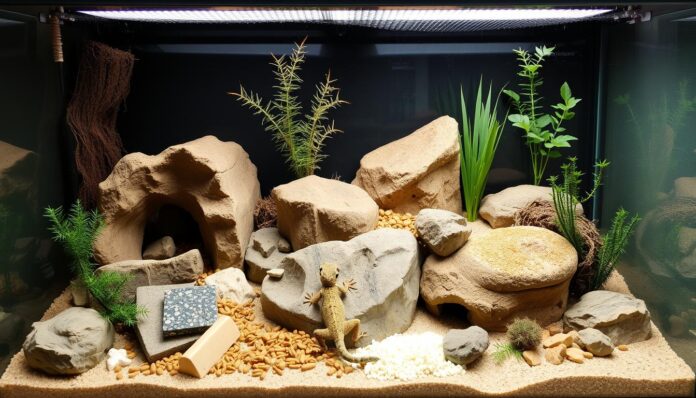Best Substrate for Leopard Gecko-Many think loose substrates are bad for leopard geckos. But, the truth is, they can be safe and healthy if used right. In fact, about 40% of arid substrate mixes, topsoil/sand blends, and desert soils are good for these reptiles. This guide will show you the best substrates, clear up myths, and give tips for a happy leopard gecko.
Choosing the right substrate is key for a leopard gecko’s health. It affects their physical health and natural behaviors. By knowing what they need, you can make a habitat that feels like home and keeps them healthy for a long time.
Understanding Leopard Gecko Natural Habitat
Leopard geckos come from the semi-desert, grassland, and dry forests of West Asia. This includes places like Afghanistan, Pakistan, India, and Nepal. Their homes are diverse, with limestone, hardened clay, and a mix of sand and gravel. These geckos are most active at twilight, hiding in crevices and burrows most of the time.
Native Environment Characteristics
Their natural world is dry and hot, with daytime temperatures between 70-90°F. At night, it can get cooler than 70°F. The landscape is rocky, with clay soil and little vegetation. This setup gives them plenty of places to hide and feel safe.
Wild Substrate Preferences
- Leopard geckos like a mix of limestone, clay, and a bit of sand and gravel in the wild.
- This mix is stable and lets them burrow safely. It also keeps moisture well.
- Don’t use just sand, as it can cause problems if eaten, mainly for young geckos.
Natural Behavior Patterns
In the wild, leopard geckos hide, burrow, and hunt for insects. Knowing their natural substrate choices and behaviors helps us create a good home for them in captivity.
Best Substrate for Leopard Gecko: Safe Options Explained
Choosing the right substrate for your leopard gecko’s home is key. You want something safe and natural. Luckily, there are many good options that mimic their natural habitat.
Fine quartz desert sand, like Zoo Med ReptiSand, is a top pick. It looks like the sand in their native home. It’s also safe for them to burrow and move around.
Natural dune sand, such as Jurassic Sands Reptile Substrate, offers a desert-like feel. It’s another great choice for your gecko’s home.
For a DIY option, mix 40% organic topsoil, 40% sand, and 20% Excavator Clay by Zoo Med. This blend is like their natural substrate. It also keeps the right humidity in their enclosure.
Bioactive setups are also a great choice. They create a self-sustaining ecosystem, like the Bio Dude Terra Sahara Bioactive Reptile Substrate. These setups encourage natural behaviors and reduce the need for frequent substrate changes.
| Substrate Option | Availability | Key Benefits |
|---|---|---|
| Fine Quartz Desert Sand (e.g., Zoo Med ReptiSand) | Available in 10-pound bags | Closely mimics natural habitat, safe for burrowing |
| Natural Dune Sand (e.g., Jurassic Sands Reptile Substrate) | Available in various package sizes | Provides an authentic desert-like environment |
| DIY Topsoil, Sand, and Excavator Clay Mixture | Topsoil and sand available in bags, Excavator Clay in 10-pound and 20-pound bags | Replicates natural substrate, helps maintain humidity |
| Bioactive Setups (e.g., Bio Dude Terra Sahara) | Available in 36-quart and 6-quart packages | Mimics natural environment, eliminates need for frequent substrate changes |
By picking safe substrates, you can make a great home for your leopard gecko. The right safe substrate leopard gecko is key for their health and happiness.

You May Like:- When Do Leopard Geckos Lay Eggs? A Complete Guide
Bioactive Substrate Solutions
Creating a bioactive substrate for your leopard gecko’s home can be a big change. It mixes organic topsoil, sand, and other stuff like bark chips and leaf litter. Adding live plants and beneficial insects makes it a self-sustaining world, just like their natural home.
Components of Bioactive Setup
- Organic topsoil
- Sand
- Bark chips or leaf litter
- Live plants
- Beneficial insects (e.g., springtails, isopods)
- Appropriate lighting and humidity control
Benefits of Bioactive Systems
Bioactive substrates for leopard geckos have many benefits. They offer a natural and enriching space for your pet to act naturally. Plus, these setups clean themselves, so you don’t have to change the substrate often. This means less work for you and less stress for your leopard gecko.
Maintenance Requirements
Keeping a bioactive leopard gecko enclosure substrate clean is key. You’ll need to mist it, care for the plants, and watch the ecosystem’s health. With the right care, you can have a beautiful and easy-to-maintain home for your leopard gecko.
Check out The Bio Dude for a wide range of bioactive substrate options. They have everything you need to create a fascinating and self-sustaining space for your leopard gecko.
Solid vs Loose Substrate Comparison
Choosing the right substrate for your leopard gecko’s habitat is key. You have solid and loose substrates to pick from. Each has its own benefits and challenges, depending on your gecko’s health and your experience.
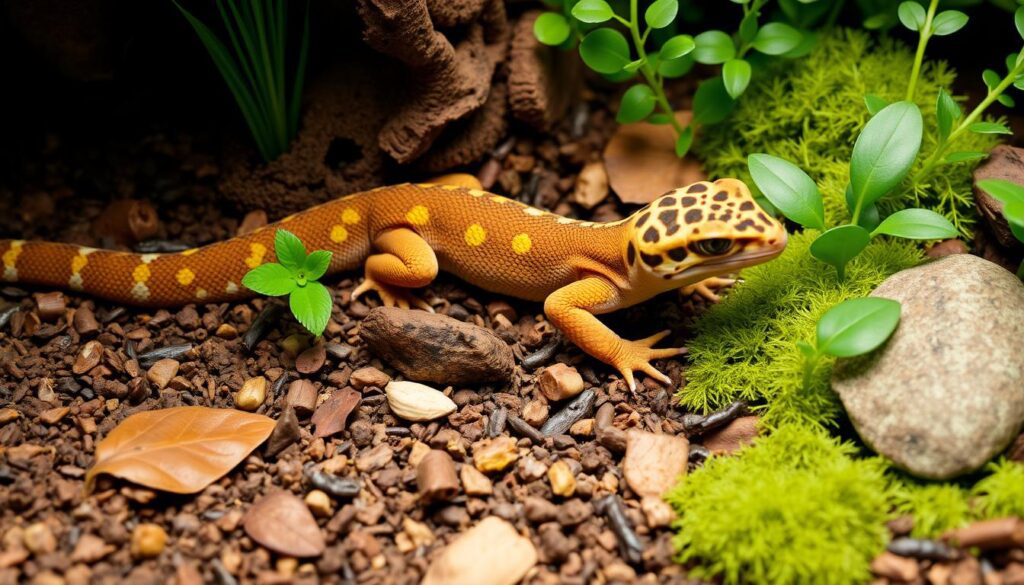
Solid substrates like paper towels and slate tiles are easy to clean. They also lower the risk of impaction. But, they might not let your gecko dig like it does in the wild.
Loose substrates such as organic topsoil and play sand let your gecko dig and forage naturally. They make your gecko’s environment feel more like home. Yet, they need more care and cost more than solid substrates.
| Solid Substrates | Loose Substrates |
|---|---|
| Easy to clean and maintain | Allows for natural digging behaviors |
| Reduced risk of impaction | Higher initial cost |
| Lack of natural digging opportunities | Require more maintenance |
Choosing between solid and loose leopard gecko bedding or gecko terrarium substrate is up to you. Think about what’s best for your gecko and your setup. Make sure to consider all the pros and cons to keep your gecko happy and healthy.
DIY Substrate Mixtures and Recipes
Making your own substrate for your leopard gecko’s home can save money and be fun. A good mix is 40% organic topsoil, 40% sand, and 20% excavator clay. Just mix it well, soak it in water, and let it dry before putting your gecko in.
Topsoil and Sand Ratios
The best mix for a leopard gecko’s home is 40% topsoil and 40% sand. This mix gives a solid base for your pet. The last 20% is excavator clay, which keeps the right moisture and helps with digging.
Mixing Instructions
- Gather the necessary ingredients: organic topsoil, clean sand, and excavator clay.
- Mix the components in a large container or on a clean surface, ensuring a thorough and even distribution.
- Slowly add water to the mixture, stirring continuously until the desired moisture content is achieved.
- Allow the substrate to dry completely before adding it to the enclosure.
Cost-Effective Solutions
Making your own substrate is a smart way to save money. You can pick the right mix for your leopard gecko’s needs. This DIY method lets you customize their home for their comfort and health.
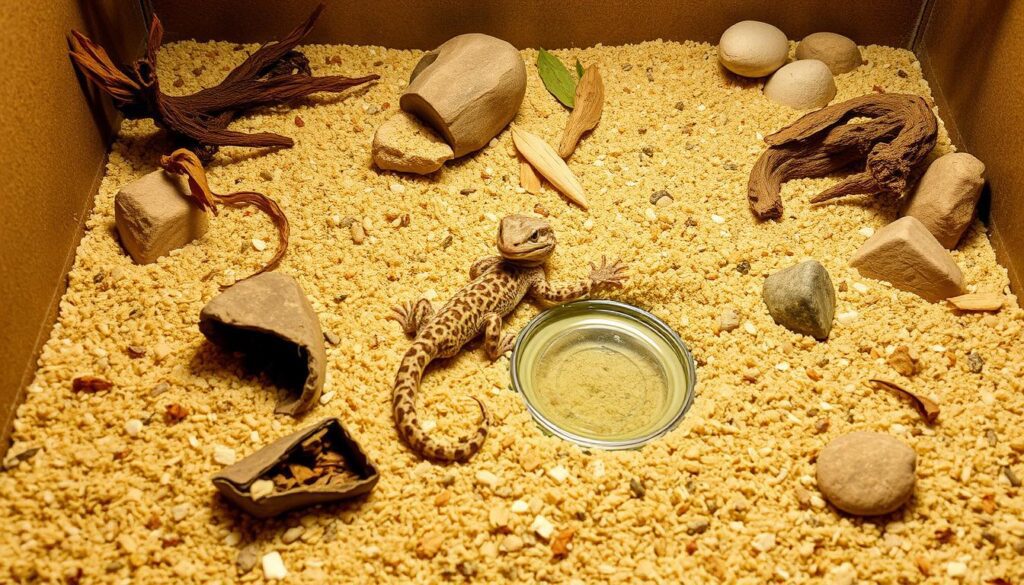
Dangerous Substrates to Avoid
Setting up a safe home for your leopard gecko is key. Avoid certain substrates that can harm them. These include calcium sand, ground walnut shells, wood shavings, gravel, and fluffy beddings. They can cause impaction, breathing problems, or injuries.
Reptile carpet is popular but can be risky. It can trap bacteria and harm your gecko’s nails. Linoleum and shelf liners also release harmful chemicals. Stay away from these.
- Calcium sand
- Ground walnut shells
- Wood shavings
- Gravel
- Fluffy beddings
- Reptile carpet
- Linoleum
- Shelf liners
Choose safer options for your gecko’s tank. Newspapers, paper towels, or a safe substrate for leopard geckos are better. Avoiding these dangers ensures a healthy home for your pet.
| Substrate | Safety Concerns |
|---|---|
| Calcium Sand | Impaction risk, respiratory issues |
| Ground Walnut Shells | Impaction, possible injuries |
| Wood Shavings | Respiratory problems, impaction |
| Gravel | Impaction, injury risk |
| Fluffy Beddings | Impaction, respiratory issues |
| Reptile Carpet | Bacterial growth, toenail trapping |
| Linoleum | Potential VOC release |
| Shelf Liners | Potential VOC release |
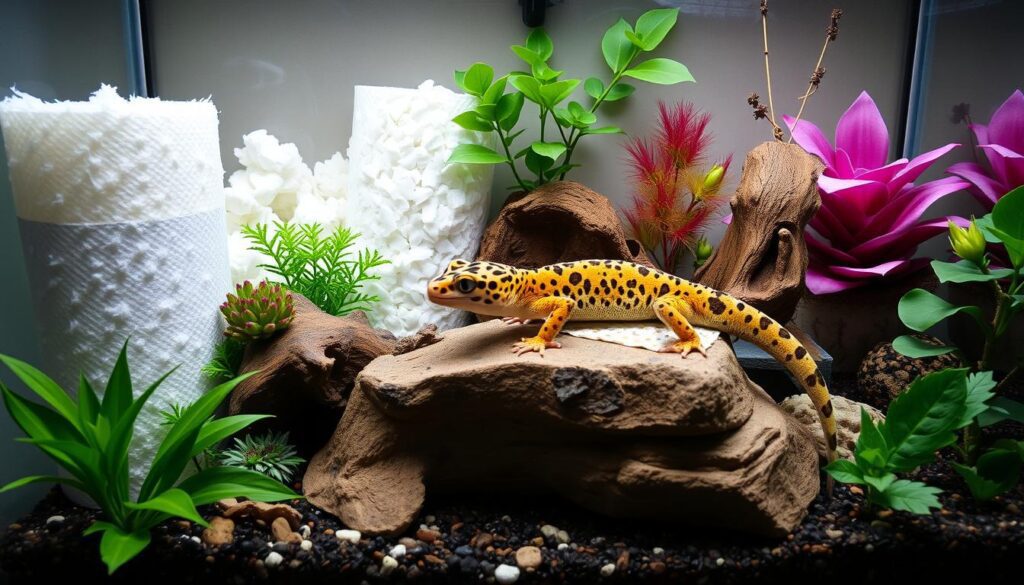
The Truth About Substrate Impaction
Many leopard gecko owners worry about substrate impaction. But, it’s often not the substrate’s fault. Instead, it’s usually due to bad care habits. To avoid impaction, focus on the real risks and clear up wrong ideas.
Risk Factors
Wrong temperatures, not enough water, and health problems are big risks. If it’s too cold, digestion slows down, making impaction more likely. Not drinking enough water can also cause constipation and lead to eating too much substrate. Plus, health issues like metabolic bone disease can raise the risk of impaction.
Prevention Methods
- Keep the right heat and humidity for good digestion
- Make sure your gecko drinks enough by using a water dish and misting the cage
- Add calcium and vitamin D3 to their food for strong bones and digestion
- Watch your gecko’s health and fix any medical problems
Common Misconceptions
Many think all loose substrates cause impaction. But, this has led to very clean cages that might not be good for geckos. Leopard geckos can handle some substrate in their diet, and studies show it’s rare in their stomachs. The real problem is bad care, not the substrate.
| Substrate Type | Potential Risks | Preventive Measures |
|---|---|---|
| Loose Substrates (e.g., sand, soil) | Impaction, respiratory issues, eye/skin irritation | Maintain proper humidity, provide a moist hide, and feed in a separate dish |
| Solid Substrates (e.g., reptile carpet, paper towels) | Bacterial harboring, physical injuries, limited natural behaviors | Regularly clean and replace the substrate, provide hiding spots and enrichment |
In summary, dealing with substrate impaction in leopard geckos needs a complete care approach. By tackling the real risks and clearing up wrong beliefs, owners can make a safe and fun home for their pets.
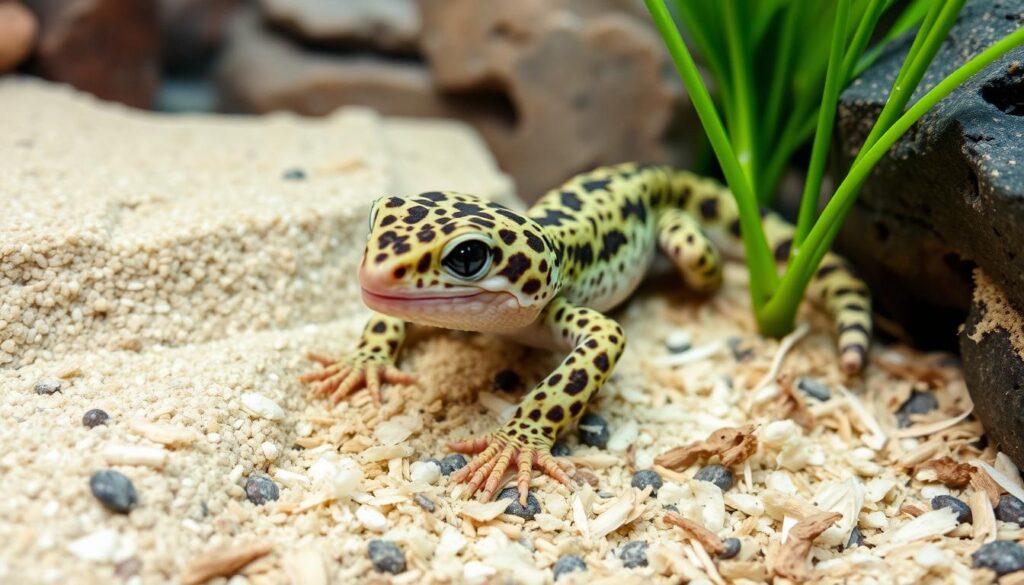
Substrate Depth and Layering Guidelines
When choosing a leopard gecko enclosure substrate or gecko terrarium substrate, think about depth and layering. Leopard geckos need a substrate that’s at least 3-4 inches deep. This lets them burrow naturally. In a bioactive setup, use 4-6 inches of substrate.
Start with a drainage layer at the bottom. This can be leca or gravel. It keeps the substrate from getting too wet. Then, add a mix of organic topsoil and play sand on top. This mimics their natural habitat.
To make the enclosure look better, add leaf litter or more sand on top. This makes the enclosure more appealing. It also gives your gecko more places to explore and behave naturally.
| Substrate Depth | Substrate Layering |
|---|---|
|
|
By following these guidelines, you can make a great environment for your leopard gecko. It will be natural and let your pet show off their natural behaviors.
Maintaining Proper Humidity with Different Substrates
Keeping the right humidity in a leopard gecko’s home is key for their health. The substrate type greatly affects humidity levels. Bioactive setups, with natural substrates, often manage humidity better. For other substrates, a humid hide with moist substrate helps keep them hydrated.
The perfect humidity for a leopard gecko’s home is 30-40%. The humid hide should be around 70-80% humidity. It’s important to mist regularly and ensure good air flow to keep humidity right, no matter the substrate.
- Bioactive substrates, like a mix of leopard gecko habitat substrate and gecko terrarium substrate, naturally keep humidity right.
- For non-bioactive setups, a humid hide with moist substrate, like sphagnum moss or coconut fiber, helps control humidity.
- It’s vital to watch humidity levels and adjust misting or air flow as needed to keep your leopard gecko comfortable.
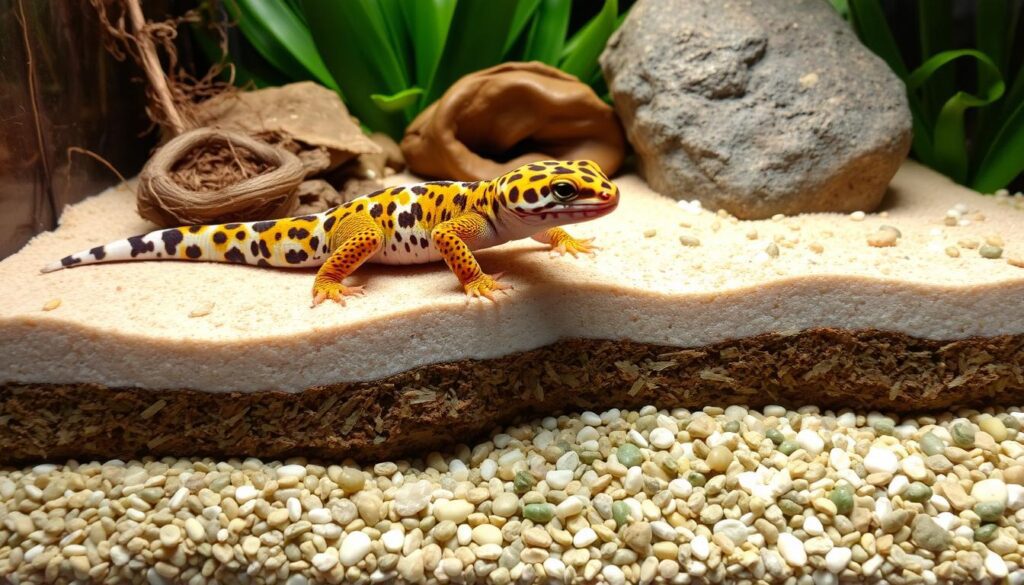
Understanding how different substrates affect humidity and using the right humidity management techniques helps your leopard gecko thrive in a balanced and cozy home.
Cleaning and Replacing Substrate
Keeping your leopard gecko’s home clean is key to their health. How often and how you clean and replace the substrate depends on what you use. This could be the leopard gecko tank lining or gecko terrarium substrate.
Regular Maintenance Schedule
Every day, do a quick clean by removing uneaten food, poop, and other mess. This keeps the space fresh and clean. For substrates like leopard gecko tank lining or gecko terrarium substrate, sift through it weekly to find dirty spots.
Deep Cleaning Procedures
Deep cleaning is needed every now and then. This means taking out all the substrate, cleaning the tank, and putting in new substrate. For leopard gecko tank lining and gecko terrarium substrate, do this every 4-6 months. Or sooner if you see mold or bacteria.
Substrate Replacement Timing
- For loose substrates like leopard gecko tank lining or gecko terrarium substrate, change part of it every 3-4 months.
- Bioactive setups might need less frequent changes, but some is always good.
- For solid substrates, like paper towels, change them every week to stay clean.
Sticking to a cleaning and replacement plan helps keep your leopard gecko’s home safe and healthy. This lets them live their best life.
| Substrate Type | Spot Cleaning | Partial Replacement | Deep Cleaning |
|---|---|---|---|
| Loose Substrates (e.g., leopard gecko tank lining, gecko terrarium substrate) | Daily | Every 3-4 months | Every 4-6 months |
| Bioactive Setups | Daily | As needed | Every 4-6 months |
| Solid Substrates (e.g., paper towels) | Daily | Weekly | Every 4-6 months |
Conclusion
Choosing the right substrate for a leopard gecko’s home is important. It must match the reptile’s natural habitat, be safe, easy to clean, and meet your preferences. Loose substrates like paper towels, sand, and coconut fiber can feel natural. But, they need constant watch and often need to be changed to avoid health problems.
Bioactive setups, with live plants and a self-sustaining ecosystem, are a natural and easy-care choice. They need a detailed setup at first. Solid substrates, like slate tiles, are clean, simple to keep, and help control temperature. This makes them a favorite among leopard gecko owners.
The best substrate for a leopard gecko depends on your needs and experience. It’s important to keep an eye on your gecko’s habitat, make changes as needed, and focus on creating a safe and stimulating space. This dedication ensures your gecko stays healthy and happy for a long time.
FAQ
What are the best substrate options for leopard geckos?
Safe substrates for leopard geckos include fine quartz desert sand and natural dune sand. You can also make your own mix using organic topsoil, sand, and excavator clay. Bioactive setups are a great choice, mimicking their natural habitat.
What should I avoid using as leopard gecko substrate?
Avoid using calcium sand, ground walnut shells, wood shavings, gravel, and fluffy beddings. These can cause impaction, breathing problems, or injuries. Also, steer clear of reptile carpet and some liners.
How do I maintain proper humidity with different substrates?
Bioactive setups naturally keep humidity right. For other substrates, use a humid hide with moistened substrate. Keep the ambient humidity at 30-40% and the humid hide at 70-80%.
How often should I clean and replace the substrate?
Clean the substrate daily. Sift and replace loose substrates weekly. Deep clean every 4-6 months. Replace solid substrates like paper towels weekly.
Can loose substrates cause impaction in leopard geckos?
Impaction is often misunderstood. While loose substrates might contribute, it’s usually due to poor care. This includes wrong temperatures, dehydration, and health issues, not the substrate itself.
How deep should the substrate be in a leopard gecko enclosure?
The substrate should be 3-4 inches deep for burrowing. In bioactive setups, use 4-6 inches for better habitat simulation.
